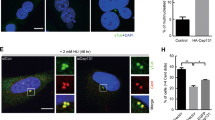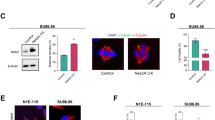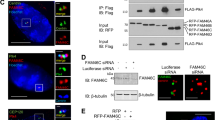Abstract
ID1 is a member of the inhibitor of DNA binding/differentiation (ID) family of dominant negative helix–loop–helix transcription factors. ID-proteins have been implicated in the control of differentiation and transcriptional modulation of various cell cycle regulators and high levels of ID1 expression are frequently detected in various cancer types. However, it is unclear whether ID1 is a marker of highly proliferative cancer cells or whether it directly contributes to the tumor phenotype. A detailed analysis of ID1-expressing human cells revealed that a fraction of ID1 localizes to centrosomes. Ectopic expression of ID1 in primary cells and tumor cell lines resulted in accumulation of cells with abnormal centrosome numbers. There was no evidence for centrosomal localization or induction of centrosome abnormalities by the other ID family members. Hence, ID1 may contribute to oncogenesis not only by inhibiting transcriptional activity of basic helix–loop–helix transcription factors and abrogate differentiation but also by subverting centrosome duplication.
This is a preview of subscription content, access via your institution
Access options
Subscribe to this journal
Receive 50 print issues and online access
$259.00 per year
only $5.18 per issue
Buy this article
- Purchase on Springer Link
- Instant access to full article PDF
Prices may be subject to local taxes which are calculated during checkout




Similar content being viewed by others
References
Alani RM, Hasskarl J, Grace M, Hernandez MC, Israel MA and Munger K . (1999). Proc. Natl. Acad. Sci., USA, 96, 9637–9641.
Alani RM, Young AZ and Shifflett CB . (2001). Proc. Natl. Acad. Sci., USA, 98, 7812–7816.
Andres-Barquin PJ, Hernandez MC and Israel MA . (1999). Exp. Cell Res., 247, 347–355.
Barone MV, Pepperkok R, Peverali FA and Philipson L . (1994). Proc. Natl. Acad. Sci., USA, 91, 4985–4988.
Benezra R, Davis RL, Lockshon D, Turner DL and Weintraub H . (1990). Cell, 61, 49–59.
Biggs JR, Zhang Y and Murphy EV . (1995). J. Cell. Physiol., 164, 249–258.
Bounpheng MA, Dimas JJ, Dodds SG and Christy BA . (1999). FASEB J., 13, 2257–2264.
Boveri T . (1914). Zur. Frage der. Entstehung. Maligner. Tumoren., Fischer: Jena.
Chen C and Okayama H . (1987). Mol. Cell. Biol., 7, 2745–2752.
Christy BA, Sanders LK, Lau LF, Copeland NG, Jenkins NA and Nathans D . (1991). Proc. Natl. Acad. Sci., USA, 88, 1815–1819.
D'Assoro AB, Lingle WL and Salisbury JL . (2002). Oncogene, 21, 6146–6153.
D'Assoro AB, Stivala F, Barrett S, Ferrigno G and Salisbury JL . (2001). Ital. J. Anat. Embryol., 106, 103–110.
Deed RW, Armitage S and Norton JD . (1996). J. Biol. Chem., 271, 23603–23606.
Deed RW, Bianchi SM, Atherton GT, Johnston D, Santibanez-Koref M, Murphy JJ and Norton JD . (1993). Oncogene, 8, 599–607.
Deed RW, Hara E, Atherton GT, Peters G and Norton JD . (1997). Mol. Cell. Biol., 17, 6815–6821.
De Souza CP, Ellem KA and Gabrielli BG . (2000). Exp. Cell Res., 257, 11–21.
Doxsey SJ . (2001). Nat. Cell Biol., 3, E105–E108.
Duensing S, Duensing A, Crum CP and Munger K . (2001). Cancer Res., 61, 2356–2360.
Duensing S, Lee LY, Duensing A, Basile J, Piboonniyom S, Gonzalez S, Crum CP and Munger K . (2000). Proc. Natl. Acad. Sci., USA, 97, 10002–10007.
Florio M, Hernandez MC, Yang H, Shu HK, Cleveland JL and Israel MA . (1998). Mol. Cell. Biol., 18, 5435–5444.
Hanahan D and Weinberg RA . (2000). Cell, 100, 57–70.
Hara E, Hall M and Peters G . (1997). EMBO J., 16, 332–342.
Hara E, Uzman JA, Dimri GP, Nehlin JO, Testori A and Campisi J . (1996). Dev. Genet., 18, 161–172.
Hara E, Yamaguchi T, Nojima H, Ide T, Campisi J, Okayama H and Oda K . (1994). J. Biol. Chem., 269, 2139–2145.
Hasskarl J, Butz K, Whitaker N, Ullmann A, Durst M and Hoppe-Seyler F . (2000). J. Mol. Med., 78, 94–101.
Hinchcliffe EH, Li C, Thompson EA, Maller JL and Sluder G . (1999). Science, 283, 851–854.
Hu YC, Lam KY, Law S, Wong J and Srivastava G . (2001). Clin. Cancer Res., 7, 2213–2221.
Iavarone A, Garg P, Lasorella A, Hsu J and Israel MA . (1994). Genes Dev., 8, 1270–1284.
Jen Y, Weintraub H and Benezra R . (1992). Genes Dev., 6, 1466–1479.
Kebebew E, Treseler PA, Duh QY and Clark OH . (2000). Surgery, 128, 952–957.
Kleeff J, Ishiwata T, Friess H, Buchler MW, Israel MA and Korc M . (1998). Cancer Res., 58, 3769–3772.
Kreider BL, Benezra R, Rovera G and Kadesch T . (1992). Science, 255, 1700–1702.
Lacey KR, Jackson PK and Stearns T . (1999). Proc. Natl. Acad. Sci., USA, 96, 2817–2822.
Langlands K, Down GA and Kealey T . (2000). Cancer Res., 60, 5929–5933.
Lasorella A, Iavarone A and Israel MA . (1996). Mol. Cell. Biol., 16, 2570–2578.
Lauricella M, Calvaruso G, Carabillo M, D'Anneo A, Giuliano M, Emanuele S, Vento R and Tesoriere G . (2001). FEBS Lett., 499, 191–197.
Lin CQ, Singh J, Murata K, Itahana Y, Parrinello S, Liang SH, Gillett CE, Campisi J and Desprez PY . (2000). Cancer Res., 60, 1332–1340.
Lingle WL and Salisbury JL . (1999). Am. J. Pathol., 155, 1941–1951.
Lyden D, Young AZ, Zagzag D, Yan W, Gerald W, O'Reilly R, Bader BL, Hynes RO, Zhuang Y, Manova K and Benezra R . (1999). Nature, 401, 670–677.
Mantel C, Braun SE, Reid S, Henegariu O, Liu L, Hangoc G and Broxmeyer HE . (1999). Blood, 93, 1390–1398.
Maruyama H, Kleeff J, Wildi S, Friess H, Buchler MW, Israel MA and Korc M . (1999). Am. J. Pathol., 155, 815–822.
Matsumoto Y, Hayashi K and Nishida E . (1999). Curr. Biol., 9, 429–432.
Matsumura ME, Lobe DR and McNamara CA . (2002). J. Biol. Chem., 277, 7293–7297.
Meraldi P, Lukas J, Fry AM, Bartek J and Nigg EA . (1999). Nat. Cell Biol., 1, 88–93.
Meraldi P and Nigg EA . (2002). FEBS Lett., 521, 9–13.
Mueller C, Baudler S, Welzel H, Bohm M and Nickenig G . (2002). Circulation, 105, 2423–2428.
Mussman JG, Horn HF, Carroll PE, Okuda M, Tarapore P, Donehower LA and Fukasawa K . (2000). Oncogene, 19, 1635–1646.
Nehlin JO, Hara E, Kuo WL, Collins C and Campisi J . (1997). Biochem. Biophys. Res. Commun., 231, 628–634.
Nickoloff BJ, Chaturvedi V, Bacon P, Qin JZ, Denning MF and Diaz MO . (2000). J. Biol. Chem., 275, 27501–27504.
Nigg EA . (2002). Nat. Rev. Cancer, 2, 815–825.
Ohtani N, Zebedee Z, Huot TJ, Stinson JA, Sugimoto M, Ohashi Y, Sharrocks AD, Peters G and Hara E . (2001). Nature, 409, 1067–1070.
Pagliuca A, Gallo P, De Luca P and Lania L . (2000). Cancer Res., 60, 1376–1382.
Paoletti A, Moudjou M, Paintrand M, Salisbury JL and Bornens M . (1996). J. Cell Sci., 109 (Part 13), 3089–3102.
Pesce S and Benezra R . (1993). Mol. Cell. Biol., 13, 7874–7880.
Peverali FA, Ramqvist T, Saffrich R, Pepperkok R, Barone MV and Philipson L . (1994). EMBO J., 13, 4291–4301.
Piboonniyom SO, Duensing S, Swilling NW, Hasskarl J, Hinds PW and Munger K . (2003). Cancer Res., 63, 476–483.
Polsky D, Young AZ, Busam KJ and Alani RM . (2001). Cancer Res., 61, 6008–6011.
Prabhu S, Ignatova A, Park ST and Sun XH . (1997). Mol. Cell. Biol., 17, 5888–5896.
Riechmann V, van Cruchten I and Sablitzky F . (1994). Nucleic Acids Res., 22, 749–755.
Roberts EC, Deed RW, Inoue T, Norton JD and Sharrocks AD . (2001). Mol. Cell. Biol., 21, 524–533.
Salisbury JL, Whitehead CM, Lingle WL and Barrett SL . (1999). Biol. Cell, 91, 451–460.
Schindl M, Oberhuber G, Obermair A, Schoppmann SF, Karner B and Birner P . (2001). Cancer Res., 61, 5703–5706.
Schindl M, Schoppmann SF, Strobel T, Heinzl H, Leisser C, Horvat R and Birner P . (2003). Clin. Cancer Res., 9, 779–785.
Schoppmann SF, Schindl M, Bayer G, Aumayr K, Dienes J, Horvat R, Rudas M, Gnant M, Jakesz R and Birner P . (2003). Int. J. Cancer, 104, 677–682.
Sun XH, Copeland NG, Jenkins NA and Baltimore D . (1991). Mol. Cell. Biol., 11, 5603–5611.
Takai N, Miyazaki T, Fujisawa K, Nasu K and Miyakawa I . (2001). Cancer Lett., 165, 185–193.
Tanaka K, Pracyk JB, Takeda K, Yu ZX, Ferrans VJ, Deshpande SS, Ozaki M, Hwang PM, Lowenstein CJ, Irani K and Finkel T . (1998). J. Biol. Chem., 273, 25922–25928.
Tang J, Gordon GM, Nickoloff BJ and Foreman KE . (2002). Lab. Invest., 82, 1073–1079.
Tarapore P and Fukasawa K . (2002). Oncogene, 21, 6234–6240.
Tarapore P, Horn HF, Tokuyama Y and Fukasawa K . (2001). Oncogene, 20, 3173–3184.
Wu CL, Classon M, Dyson N and Harlow E . (1996). Mol. Cell. Biol., 16, 3698–3706.
Xu X, Weaver Z, Linke SP, Li C, Gotay J, Wang XW, Harris CC, Ried T and Deng CX . (1999). Mol. Cell, 3, 389–395.
Acknowledgements
We thank M Bornens for the centrin-GFP construct, S Piboonniyom for normal oral keratinocytes, R Benezra for ID1−/− MEFs, and E B Affar for wild-type MEFs. JH is especially grateful for the extraordinary support of Katja Hasskarl. This work was supported by Public Health Service Grant R01 CA66980 (KM), and by postdoctoral fellowships HA3185/1-1 and DU343/1-1 from the Deutsche Forschungsgemeinschaft to JH and SD, respectively.
Author information
Authors and Affiliations
Corresponding author
Rights and permissions
About this article
Cite this article
Hasskarl, J., Duensing, S., Manuel, E. et al. The helix–loop–helix protein ID1 localizes to centrosomes and rapidly induces abnormal centrosome numbers. Oncogene 23, 1930–1938 (2004). https://doi.org/10.1038/sj.onc.1207310
Received:
Revised:
Accepted:
Published:
Issue Date:
DOI: https://doi.org/10.1038/sj.onc.1207310
Keywords
This article is cited by
-
The Id-protein family in developmental and cancer-associated pathways
Cell Communication and Signaling (2017)
-
A novel role of the aryl hydrocarbon receptor (AhR) in centrosome amplification - implications for chemoprevention
Molecular Cancer (2010)
-
Elevated endogenous expression of the dominant negative basic helix-loop-helix protein ID1 correlates with significant centrosome abnormalities in human tumor cells
BMC Cell Biology (2010)
-
Inhibitor of differentiation 4 (Id4) is a potential tumor suppressor in prostate cancer
BMC Cancer (2009)
-
Smad3 mediates immediate early induction of Id1 by TGF-β
Cell Research (2009)



